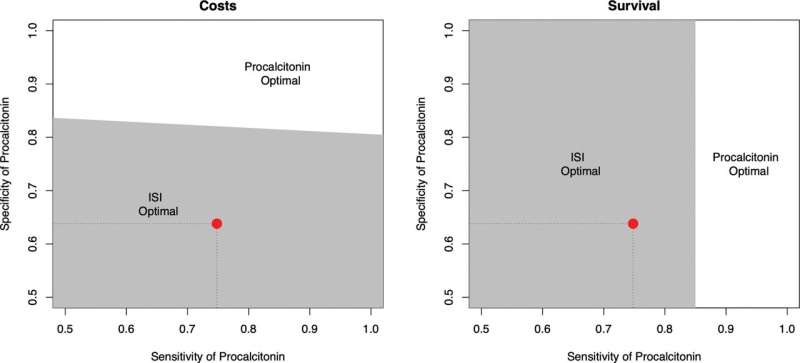This article has been reviewed according to Science X's editorial process and policies. Editors have highlighted the following attributes while ensuring the content's credibility:
fact-checked
trusted source
proofread
New test for sepsis could save lives in emergency departments, study suggests

Sepsis is a life-threatening medical emergency that occurs when an infection causes a chain reaction throughout the body that can lead to the failure of multiple organs in rapid succession. In the United States about 350,000 people die from sepsis each year, according to the Centers for Disease Control and Prevention, making proper diagnosis a matter of life-or-death importance.
When a patient who is at higher risk for sepsis—typically older adults and people with chronic health conditions like kidney disease or cancer—enters a hospital through the emergency department, doctors screen them for sepsis. There is no test that can definitively diagnose sepsis, so doctors employ judgment to identify the combination of infection and inflammation associated with the condition.
Interdisciplinary research led by Christopher Hollenbeak, professor of health policy and administration in the Penn State College of Health and Human Development, found that a new blood test for sepsis could save lives and money. The results are published in Critical Care Explorations.
The IntelliSep test characterizes changes in a patient's white blood cells to provide a rapid evaluation of whether the patient is at high risk of sepsis. Hollenbeak, a health economist, and his team modeled the economics of using the IntelliSep test in hospital emergency departments.
"One of the tools that health economists use frequently is decision modeling," Hollenbeak said. "In decision modeling, we use a mathematical model to calculate the likely outcome and cost of a specific decision. In this case, we evaluated the cost and benefit of using the IntelliSep test on patients who are suspected to have sepsis."
Hollenbeak explained that there are no value judgments associated with decision modeling.
"We provide straightforward information like, "This is what an innovation will cost to implement," and "This is the result you can expect for your investment,'" Hollenbeak said. "Then doctors, health systems, and other stakeholders can use our analyses to make decisions about what to incorporate into the care they provide. In the case of this test for sepsis, using it could save people's lives."
The company Cytovale developed and tested IntelliSep. They then reached out to Hollenbeak to conduct decision modeling on IntelliSep to understand the costs and benefits of the test. Hollenbeak said analyses like this study are common in health economics. When a medical innovation—a procedure, drug or test—is created, it must be evaluated. Once medical testing has shown the innovation to be safe and effective, there are still questions about whether it provides enough health benefits relative to the cost of widespread use.
Health economists take available data about the innovation and combine it with other data about the health care context to explore situations where there is uncertainty about the overall benefits of the innovation. This lets health economists examine how different pieces of information—like cost and effectiveness—might influence whether health care providers should use the innovation.
For this analysis, researchers used data from a trial of the IntelliSep test conducted at the Louisiana State University Health Sciences Center in Baton Rouge. They compared these data with data about another available test that can be used to indicate sepsis: measures of patients' procalcitonin levels. The researchers said they used procalcitonin testing as a comparison because it was the best widely available test for sepsis.
Procalcitonin is a biomarker that the body releases in response to infection. It can be measured with a simple blood test. Studies have shown that procalcitonin levels can be used to help diagnose sepsis, but procalcitonin only indicates the presence of infection and not the inflammation associated with sepsis. The research team said that procalcitonin testing is not part of current clinical guidelines and that medical practitioners have never widely favored the use of procalcitonin tests over the use of judgment.
Results from this study indicated that IntelliSep performed better than procalcitonin testing. The use of the IntelliSep test could result in more than 95% of patients surviving with a treatment that costs less than $4,000 per person. This was a slightly higher survival rate and lower cost than testing procalcitonin levels.
Most of the cost savings resulted because more people would be accurately diagnosed with sepsis, according to Hollenbeak. People with sepsis who go undiagnosed can become very expensive to treat and are at significantly greater risk of dying.
"For patients who have sepsis, getting sent home from the hospital is very serious because they can suffer multiple-organ failure within hours," Hollenbeak said. "Every year, there are patients who enter the emergency department of a hospital, present with a limited number of sepsis symptoms and are sent home. This test could save many of those people's lives."
Hollenbeak emphasized that the test cannot replace quality clinical care. Instead, the test would function as a diagnostic tool for clinicians.
"Admitting someone to the hospital is a serious decision," Hollenbeak said. "It inconveniences the patient and costs a lot of money. In medical care, all doctors have to make decisions in the face of uncertainty, so they always need the best information possible. If emergency department doctors can get information quickly about the likelihood that someone has sepsis, that is going to be very useful to them."
More information: Christopher S. Hollenbeak et al, Costs and Consequences of a Novel Emergency Department Sepsis Diagnostic Test: The IntelliSep Index, Critical Care Explorations (2023). DOI: 10.1097/CCE.0000000000000942


















